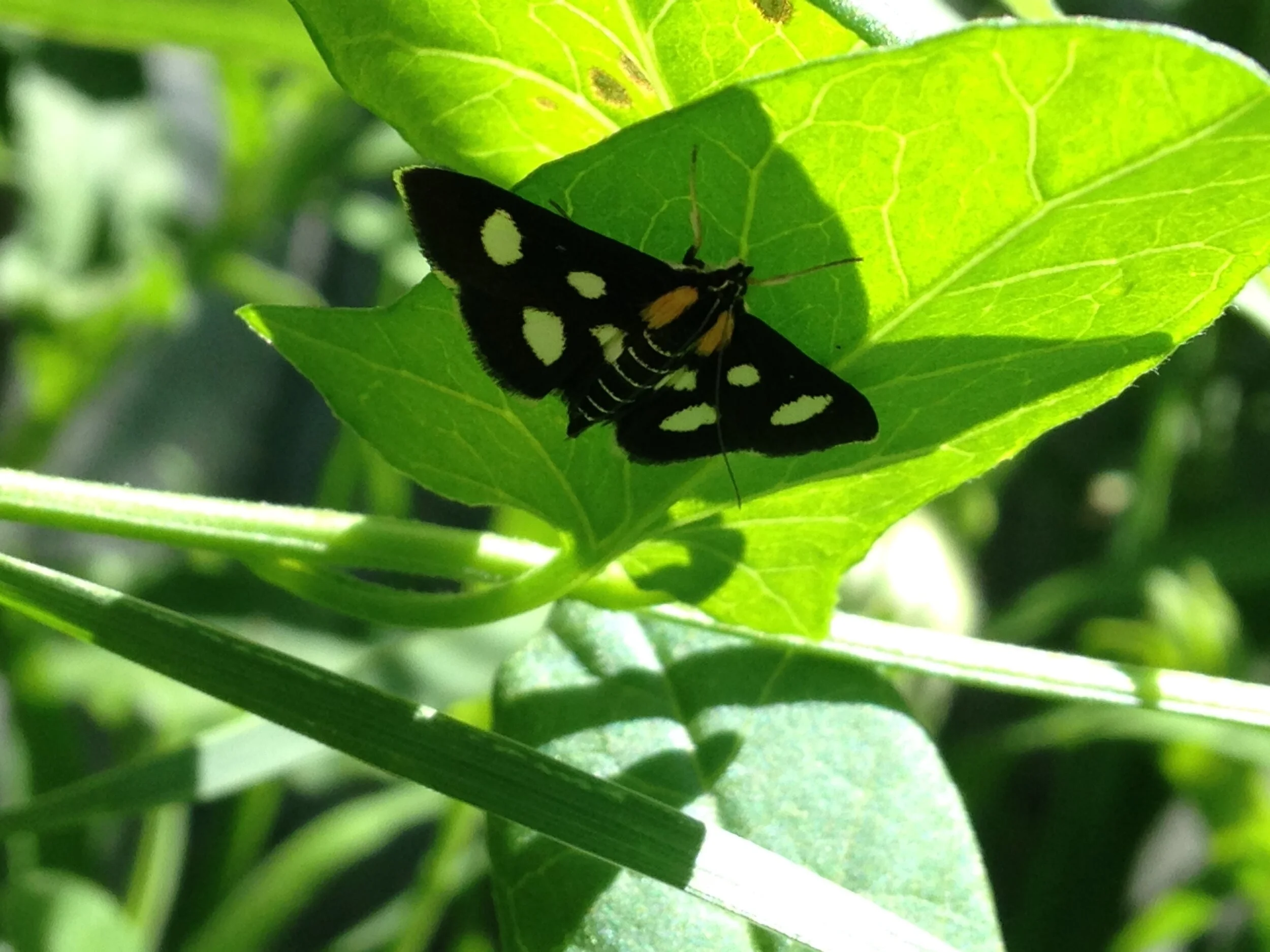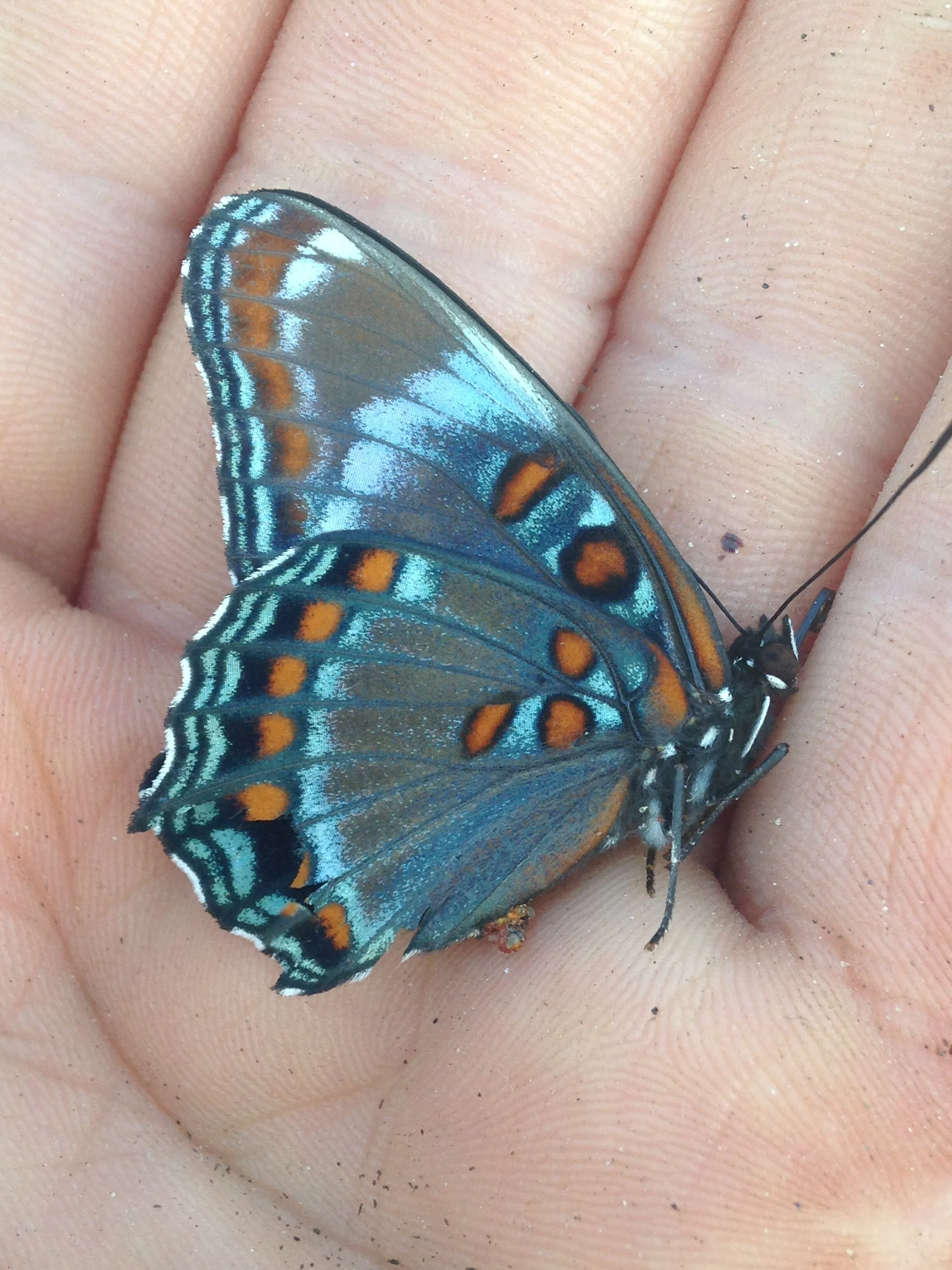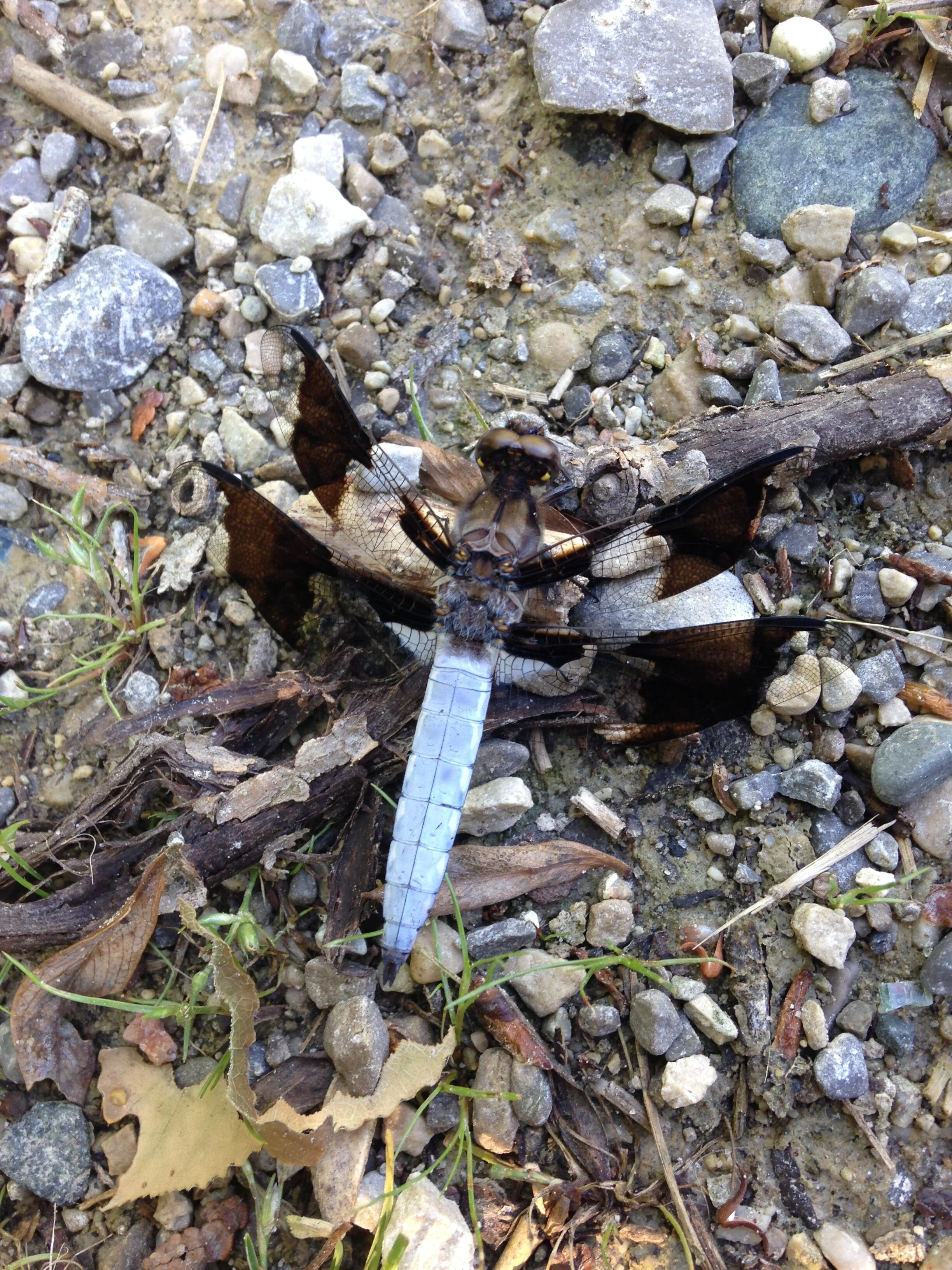Who’s this flying bug? Late Spring 2021
I know it’s past the Summer Solstice, but I found most of these bugs before the Solstice so I am counting them as such. Here are some species I am seeing out on the land that I want to learn more about.
Eight-spotted Forester Moth (Alypia octomaculata), 16.06.2021.
The Eight-spotted Forester Moth (Alypia octomaculata) is the most popular member of the genus Alypia, which comes from New Latin, perhaps from Greek, meaning freedom from pain or grief, from alypos + -ia, which made sense to me. When I saw this moth hanging out on the Bittersweet Nightshade (Solanum dulcamara), I was certainly put in such a mood that I forgot all about any pain or grief I had. This beautiful individual waited around long enough for me to get a couple of photos before flying off out of view. I had seen the bright white wing spots but didn’t count them. Octomaculata, the species name literally translates to “eight spotted”. I love it when the scientific names offer relevant information.
Common flight time : Late April to June.
Where to find them : Woodlands and forest edges.
Grapevine Epimenis (Psychomorpha epimenis), 22.06.2021.
The caterpillars of the Eight-spotted Forester feeds on Virginia Creeper (Parthenocissus quinquefolia) and Grape (Vitis spp.). All Forester caterpillars (subfamily Agaristinae) need dense material to spend winters and pupate within. This material can be punky wood, dense peat, or even styrofoam in more urban environments. The adults moths emerge between late April to June and fly during the day.
I have also recently found a close relative of Alypia octomaculata, the Grapevine Epimenis (Psychomorpha epimenis) crawling out of burrowed hole in an old woodend post bordering a parking lot. I was lucky enough to get a photo, too.
Golden-backed Snipe Fly (Chrysopilus thoracicus)
The kids saw this one before I did, and what a find! Look at that golden hair behind the head. What a mane. Something out of a fairy tale or something. This is the Golden-backed Snipe Fly (Chrysopilus thoracicus). The genus name Chrysopilus means “golden haired” and thoracicus refers to the gold patch on the thorax. “Golden haired thorax”; Again, another useful name. These flies are part of the Snipe fly family, or Rhagionidae.
Common flight time : unknown but commonly seen around end of May-early June to mid-July.
Where to find them : Woodland or thickety edges bordering wet meadows and riparian areas.
These two are mating. The females are larger and they have a space between their eyes as you can sort of make out in the photo above. These flies are a little bit bigger than the ones you might see flying around the house, but not by much. Their legs are longer, heads rounder and they have tapered abdomens, three traits typical of the small Rhagionidae family.
I have read that these flies like deciduous woodland habitat, but I’ve found them in more wet meadowy, riparian coniferous areas, with lots of transitions between varied habitats, including deciduous woodland, but I have not seen them in the woods proper.
There doesn’t seem to be much research out there about these flies, but many folks seem to suggest that they consume other insects, or at least parts of them. They pierce their prey with their proboscis, inject liquefying agents and then suck everything out, leaving the rest of the insect behind. Lots of other insects do this, so why not the golden flies with the big round heads?
Red-Spotted Purple (Limenitis arthemis astyanax), 09.06.2021.
It rained for the past couple of days, but today, hot and humid, I saw a dozen or so Red-Spotted Purples (Limenitis arthemis astyanax) while out running, then later biking today, including two sad looking ones by the side of the road this morning.
The Red-Spotted Purple is my favorite butterfly. They are just so beautiful with their pale and dark blues with small red spots occassionally seen on the hind wings on the dorsal side and definitely noticeable on the ventral side.
Common flight time : Middle of May to September, peak between mid-June to mid-August.
Where to find them : Puddles on gravel trails, roadsides, woodland edges.
Fairly beat up White Admirable (Limenitis arthemis arthemis), 21.07 2020
I often see them out in abundance after the rain, along the edges of puddles on gravel roads where they are sucking up mineral rich water. They feed on tree sap, decaying fruits, animal scat and may visit the occasional flower for nectar, but I have never seen that.
Red-spotted Purples were once considered a completely different species than White Admirables (sometimes called “Admirals”, Limenitis arthemis arthemis) but nowadays they are considered two subspecies with the Admirables hanging out a little further North than the Purples, but in my area the populations overlap. The two subspecies can breed and create new variable patterns somewhere between the two. They may also breed with Viceroys (Limenitis archippus), but this might to be a more southern occurrence.
As caterpillars they look like bird scat. Big chunky green and bird scat with a bit of white on them to mimic the uric acid, and I have found these turdy caterpillars on Trembling Aspens (Populus tremloides) before.
Red-Spotted Purple (Limenitis arthemis astyanax), 21.06.2019.
Common Whitetail (Plathemus lydia), breeding male. 15.06.2021.
You know how you know some species by name but you don’t really know anything about them? Well, the Common Whitetail (Plathemus lydia) is like that for me. I can name them as I see them, and get excited about seeing them, but really I know nothing about them. Until deciding to post them here.
Common flight time : Late May to late August
Where to find them : Ponds, puddles, quiet streams, gravel trails and parking lots close to water.
I always see the Common Whitetails along the bike trails, basking in the sun, when I am heading home from work. I am heading uphill, as fast as I can and these Odonata (the Order of Dragonflies and Damselflies) zip out of the way just before I can get close enough for a good look. Luckily the male in the photo above had just survived a pretty cool night and was warming in a parking lot at work when someone pointed them out to me.
So the males have that whiteish, blueish tail. This is the feature I find so damned beautiful. How can you not be interested? Anyhow, this colouration is just a layer of a waxy substance that researchers assume is for helping them keep their abdomens cool or for use in signaling territories to other males. I need to look into that more. Why would all the males have it if it was used to signal to other males? This waxy production is called “pruinescence”.
When the adult swarms of Common Whitetails emerge every year they’re really hungry. They like to eat mosquitos, flies, butterflies, moths, mayflies, and flying ants or termites, which is just about any insect with a soft body… so be sure to thank them when you are out on an evening walk free of mosquitos.
Something to note is the difference between male and female Whitetails. Below is a photo I took of a female last year near about the same place. The females can be easily confused with another species of dragonfly, the Twelve-spotted Skimmer (Libellula pulchella) but the female Whitetail is smaller and the pale white or yellow markings on the abdomen is a broken line, where as the female Skimmer is larger, and the white or yellow lines on the abdomen are more-or-less seamless.
Common Whitetail (Plathemus lydia), female. 21.07.2020.








